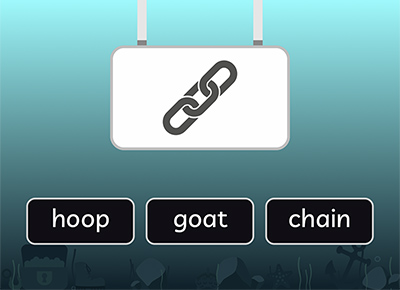PhonicsPlay Neptune Moon Zoom - Phase 3

A fun filled app involving a sequence of mini games for rehearsing the skills taught in Phase 3 phonics. The app follows a similar pattern to the Phase 2 app but this app is set in the underground ocean that some scientists believe may exist deep inside Triton, the largest of Neptune's moons. This app has three levels to choose between.
Level 1 rehearses: j, v, x, z, qu, ch, sh, th, ng
Level 2 rehearses: ai, ee, igh, oa, oo, ch, sh, th, ng
Level 3 rehearses: ar, or, oi, ow, ur, air, ear, er
See below for details of how each mini game develops skills.
The mini games

Listen to the phoneme then click the planet with the matching grapheme.
Grapheme Match
So what are they learning? Children are learning to recognise which phonemes match with which graphemes.
A phoneme is a speech sound.
A grapheme is a way of writing a speech sound.
In most cases a grapheme is simply a letter but sometimes two or more letters make one sound e.g. ck.
Why? These are the basic building blocks of the phonic code.

Say the phonemes and blend them together to read the word then touch the matching picture.
Pick a picture
So what are they learning? Children are learning the skill of blending. This is where children say all the phonemes that are shown by the graphemes and blend these together to hear what the word is.
Why? Blending is a vital skill in learning to read new words.

Blend to read the word then drag the scooter to the right alien. Bob loves real words, Obb loves fake words.
Who gets the scooter?
So what are they learning? Children are practising blending.
Why? Fake words are used to give children the chance to tackle unfamiliar words. They will have to blend to work out these words and can't rely on having learned words off by heart. Learning words off by heart is a great skill to have but doesn't enable children to independently have a go at reading the many new words that they should encounter every day. For further explanation of why fake words are so useful see Phonics FAQs.

Segment the word that is shown in the picture then drag the bubbles to the portholes to spell the word.
Bubble trouble
So what are they learning? Children are learning the skill of segmenting. This is where children say a word and then split the word into the phonemes that make it up. They can then choose a grapheme that matches each phoneme to spell the word.
Why? Segmenting is a vital skill in learning to spell words.

Use blending skills to read each sentence and choose the one that matches the picture.
Sentence match
So what are they learning? Children are learning to use their phonics skills to read words in sentences.
Why? Phonics knowledge and skills are only any use in the real world if they can be applied when reading full sentences. Reading full sentences as a part of rehearsing phonics skills can help children to take what they have learned in phonics sessions and begin to make use of those skills when reading independently.

Work out how many phonemes (NOT letters) there are in the word.
Phoneme count
So what are they learning? Children are learning to work out how many phonemes there are in words (rather than how many letters).
Why? It is important that children begin to understand that some letters work together to make one sound and therefore the number of phonemes in a word may not be the same as the number of letters. It is also very important when spelling to be able to hear how many phonemes there are in a word.

Blend to read the words and choose the one that matches the picture.
Pick a word
So what are they learning? Children are learning to blend.
Why? Blending is a key skill in learning to read.

Blend to read the sentence and follow the instructions.
Bob says...
So what are they learning? Children are learning to use their phonics skills to read words in sentences.
Why? Phonics knowledge and skills are only any use in the real world if they can be applied when reading full sentences. Reading full sentences as a part of rehearsing phonics skills can help children to take what they have learned in phonics sessions and begin to make use of those skills when reading independently.

Listen to the phoneme and click the space-submarines with the matching graphemes.
Submarine spotting
So what are they learning? Children are learning to recognise which phonemes match with which graphemes.
Why? These are the basic building blocks of the phonic code.

The more questions you get right, the more buttons you earn. Which one will you try?
Take the space-submarine for a spin
By correctly answering earlier questions, children will have earned a number of control buttons for the space-submarine. Which button will they try?
Then it's time to start all over again.

